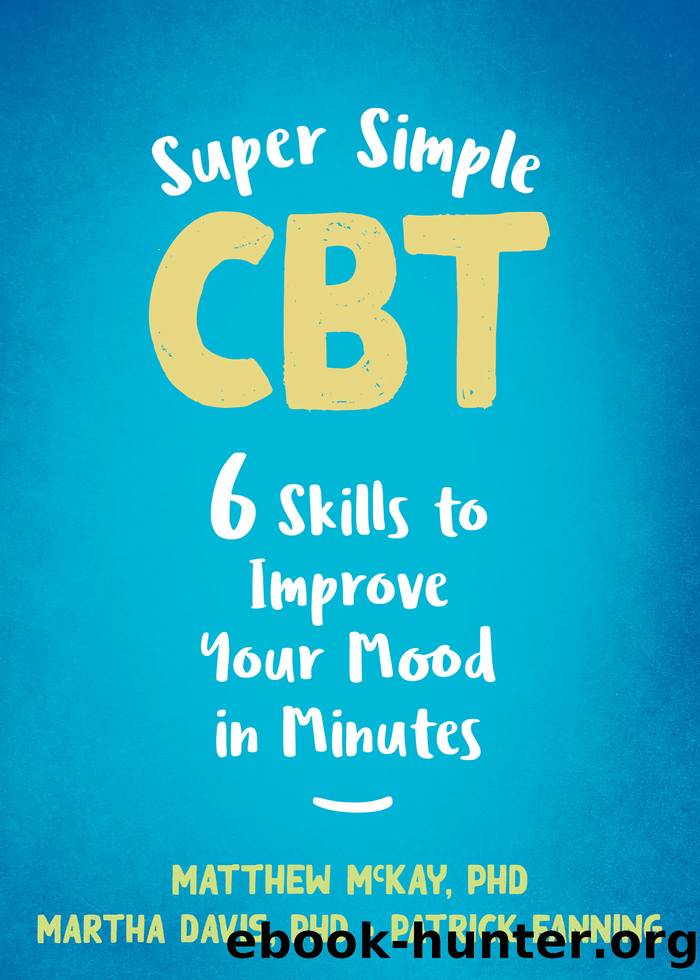Super Simple CBT by Matthew McKay

Author:Matthew McKay
Language: eng
Format: epub
Publisher: New Harbinger Publications
Published: 2022-01-05T17:15:46+00:00
Using the Thought and Evidence Journal described in this chapter, you can make significant changes in your moods in as little as one week. However, it will take from two to twelve weeks to consolidate your gains, as your new, more balanced thoughts gain strength through repetition.
Chapter 4:
Relaxation
Relaxation training differs from what we normally think of as relaxing. Itâs more than watching a movie to take your mind off things or going for a long, quiet walk to unwind. When psychologists talk about learning to relax, they are referring to regularly practicing one or more of a group of specific relaxation exercises. These exercises often involve a combination of deep breathing, muscle relaxation, and visualization techniques that have been proven to release the muscular tension that the body stores during times of stress.
During your relaxation training sessions, you will discover that racing thoughts start to slow and feelings of fear and anxiety ease considerably. In fact, when your body is completely relaxed, itâs impossible to feel fear or anxiety.
In what is called the relaxation response, heart rate, breath rate, blood pressure, skeletal muscle tension, metabolic rate, oxygen consumption, and skin electrical conductivity all decrease. On the other hand, alpha brain-wave frequency, which is associated with a state of calm well-being, increases. Every one of these physical conditions is exactly opposite to reactions that anxiety and fear produce in the body. Deep relaxation and anxiety are physiological opposites
This chapter focuses on highly effective techniques that, when practiced regularly, can bring about deep states of relaxation.
Initially, youâll want to do your relaxation training in a quiet room where you wonât be disturbed. Wear loose, nonbinding clothing. At the start of each exercise, assume a comfortable position, either lying down or sitting, in which your body feels well supported. If you wish, you can use white noise, such as a white noise machine or the humming of a fan, to cover up sounds that you have no control over.
Later, when youâre more familiar with the exercises, you can try them in more distracting settings and public places.
Download
This site does not store any files on its server. We only index and link to content provided by other sites. Please contact the content providers to delete copyright contents if any and email us, we'll remove relevant links or contents immediately.
Should I Stay or Should I Go? by Ramani Durvasula(7568)
Why We Sleep: Unlocking the Power of Sleep and Dreams by Matthew Walker(6618)
Fear by Osho(4662)
Flow by Mihaly Csikszentmihalyi(4636)
Rising Strong by Brene Brown(4380)
Why We Sleep by Matthew Walker(4361)
The Hacking of the American Mind by Robert H. Lustig(4319)
How to Change Your Mind by Michael Pollan(4292)
Too Much and Not the Mood by Durga Chew-Bose(4276)
Lost Connections by Johann Hari(4098)
He's Just Not That Into You by Greg Behrendt & Liz Tuccillo(3834)
Evolve Your Brain by Joe Dispenza(3613)
The Courage to Be Disliked by Ichiro Kishimi & Fumitake Koga(3415)
Crazy Is My Superpower by A.J. Mendez Brooks(3332)
In Cold Blood by Truman Capote(3311)
Resisting Happiness by Matthew Kelly(3303)
What If This Were Enough? by Heather Havrilesky(3275)
The Book of Human Emotions by Tiffany Watt Smith(3238)
Descartes' Error by Antonio Damasio(3231)
